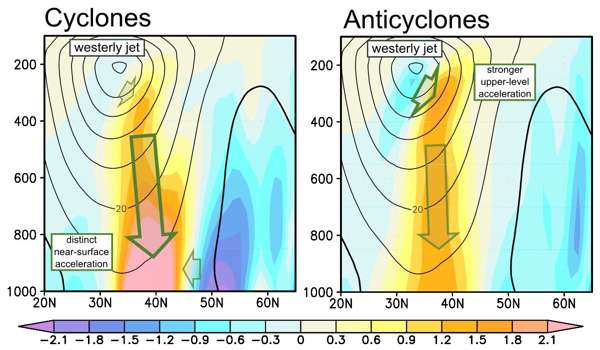Migrating storms and local weather systems are known as cyclones and anticyclones were thought to contribute to our global weather system’s behaviors and properties. However, the tools available to investigate cyclones and anticyclones were limited. Researchers demonstrated a new three-dimensional analytical methodology for quantifying the impact of individual cyclones and anticyclones on larger weather systems. This research contributes to longer-term circulation and climate studies, such as how storm characteristics may change in the future.
Researchers demonstrated for the first time a new three-dimensional analytical methodology capable of quantifying the impact of individual cyclones and anticyclones on larger weather systems. This research contributes to longer-term circulation and climate studies, such as how storm characteristics may change in the future.
Many people associate the term cyclone with ferocious storm winds or the tornadoes central to the plot of The Wizard of Oz. However, cyclones and anticyclones are part of a larger set of large-scale weather phenomena that, as it turns out, are critical to how our global climate works.
Researchers demonstrated a new three-dimensional analytical methodology that can quantify the way individual cyclones and anticyclones impact broader weather systems.
Cyclones are simply winded systems that rotate around a low-pressure area. These rotate clockwise south of the equator and counterclockwise north of the equator, indicating rainy or stormy weather. Anticyclones, on the other hand, are weather systems that rotate around areas of high pressure and tend to indicate calmer and sunnier conditions. These rotate the opposite way to cyclones in either hemisphere.
“For decades, atmospheric scientists have used a technique known as the Eulerian approach (named after 18th-century mathematician Leonhard Euler) to analyze long-term three-dimensional atmospheric data,” said Satoru Okajima of the University of Tokyo’s Research Center for Advanced Science and Technology (RCAST). “The approach, however, considers cyclones and anticyclones to be merely deviations from a background average, rather than distinct entities in their own right. Furthermore, unlike cyclones, anticyclones are frequently ignored unconsciously, possibly due to their association with calmer weather.”

Okajima, RCAST’s Professor Hisashi Nakamura, and Israel’s Weizmann Institute of Science’s Professor Yohai Kaspi used a novel technique to separate data from winds rotating around an area of low or high air pressure from ever-present background winds such as the westerly jet stream, the fast-flowing air currents between 30 degrees and 60 degrees latitude in both hemispheres. This method allowed the team to assess the impact of local curvature, or the shape of cyclones and anticyclones, on the westerly jet stream. This is in contrast to relative vorticity, one of the previous standard ways to view these patterns, which could not reveal such fine details.
The warming of the surface ocean caused by anthropogenic (man-made) climate change is most likely fueling more powerful TCs. Individual TCs’ destructive power through flooding is amplified by rising sea level, which almost certainly has a significant global contribution from anthropogenic climate change. Furthermore, TC precipitation rates are expected to rise as a result of increased atmospheric moisture caused by anthropogenic global warming.
“It was extremely difficult to quantitatively separate the cyclones from the anticyclones, and many attempts failed along the way. However, our successful method can now be applied to various climate-model simulations, which should help researchers better forecast the future of our warming climate “Okajima stated. “Climate science is important to all of us because it affects so many aspects of our lives. However, it is also particularly intriguing because it combines so many subfields, including oceanography, hydrology, computer science, physics, chemistry, and mathematics. I hope that our contribution can help climate scientists make predictions about our ever-changing world.”
















